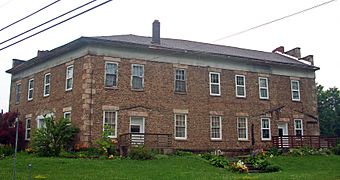Cobblestone Inn facts for kids
Quick facts for kids |
|
|
Cobblestone Inn
|
|

East elevation and south profile, 2010
|
|
| Location | Oak-Orchard-on-the-Ridge, NY |
|---|---|
| Nearest city | Lockport |
| Area | 1.3 acres (5,300 m2) |
| Architectural style | Greek Revival |
| MPS | Cobblestone Architecture of New York State MPS |
| NRHP reference No. | 07000755 |
| Added to NRHP | July 24, 2007 |
The Cobblestone Inn is a historic building in Oak-Orchard-on-the-Ridge, New York. It sits along Ridge Road (which is NY 104). This unique building is made from cobblestones. It was built in the 1830s.
Back then, it was a busy stop for stagecoaches. These were like old-time buses that carried people and mail. The inn stayed open for many years, even after trains became popular. People believe it is the biggest cobblestone building in New York State. In 2007, it was added to the National Register of Historic Places. This means it's a special building worth protecting.
Contents
What Does the Cobblestone Inn Look Like?
The Cobblestone Inn is found at the corner of Route 104 and Oak Orchard River Road. It's close to where the road crosses the Oak Orchard River. The building sits on a slightly raised piece of land. This makes it stand out a bit from the street.
Building Design and Materials
The inn is a two-story building shaped like the letter "L". It has many windows, called bays. The building is covered in small, rounded stones called cobblestones. These stones are laid in neat rows. Larger sandstone blocks, called quoins, are used at the corners.
The roof is sloped and has one brick chimney in the middle. You can also see wide, flat bands of wood, called a frieze, under the roof's edge. The window sills and tops (lintels) are also made of sandstone. On the east side, there are two modern wooden porches.
Inside the Inn
When you enter the inn from the south, you find a long hallway. This hall leads to a large room. Beyond that are smaller rooms that were likely used for services. The second floor also has a similar large room. It also has many smaller guest rooms.
Much of the original plaster and woodwork is still inside. The main staircase is also original. It has its first steps, posts, and railings.
A Look Back: History of the Inn
The way the cobblestones are laid suggests the inn was built between 1836 and 1845. This was a busy time for stagecoach travel. The inn was a very popular stop on a competitive route. It is thought to be the largest cobblestone home in North America.
Changes Over Time
Over the years, travel changed. First, the Erie Canal opened, then trains became popular. This meant fewer stagecoaches. But the inn found new ways to serve the community. It was not just a place for travelers to rest. It also had a bar and dining area. It was even used as a meeting place for the town. For a while, it was the local post office too.
When cars became popular in the 1920s, the inn became busy again. It served as a guest house and restaurant. However, when the New York State Thruway was built in the mid-1900s, business slowed down. The inn was then used as a guest house, restaurant, and antique shop until 2010. After that, it became a private home. It has stayed that way, with no major changes.
Hidden Secrets of the Inn
The first floor of the inn had a large community room. This room was used for town meetings and dining. It also served as the post office for Oak Orchard until the early 1900s. The inn had five rooms on the main floor. This included a very large dining room and a bar. There was also a kitchen and rooms for servants.
A restroom on the first floor was once a staircase. This staircase led to the cellar. Food was prepared in the cellar in the early 1800s. You can still see parts of the old bake oven. There was also a secret passage from the cellar. This passage led under Oak River Road. It is believed to have been used for secret transport or hiding things. The tunnel collapsed in the 1950s and was filled in.
Upstairs, there were two staircases. One was for guests, leading to seven guest rooms. The other was off the kitchen for the caretakers. The caretakers' room even had a small space for children. A door on the second floor separated the guests from the caretakers. There is also a small hidden space that can only be reached from the attic. Old drawings were found on the walls there. Some original wallpaper with gold leaf was also found. Samples of these wallpapers are now at the Cobblestone Museum in Albion, NY.
Images for kids




